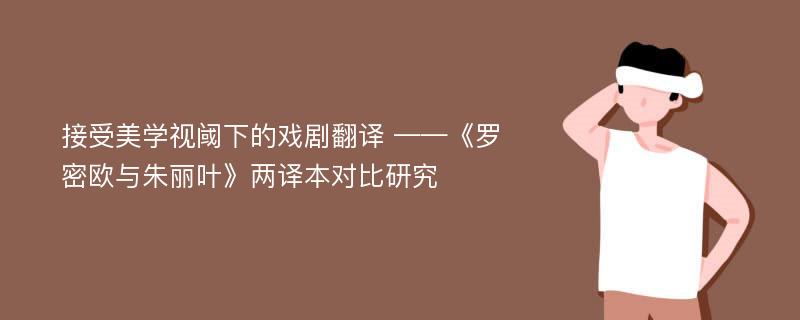
论文摘要
作为文学翻译的一个重要组成部分,戏剧翻译的历史可谓源远流长。然而,一直以来,学术界给予戏剧翻译的关注却非常有限。究其原因,主要在于戏剧文本的“双重性”:一部戏剧作品既可以被看作是文学作品,也可以作为剧本用于舞台演出。戏剧文本的“双重性”决定了戏剧翻译的特殊性。译者面对的是两种不同类型的受众,一种是纯文学读者,.另一种是剧院的观众。因此,同一部戏剧作品可能会有几个以不同受众为服务对象的译本,比如莎士比亚的早期作品Romeo and Juliet就有四个风格迥异的中译本。其中最典型的是朱生豪和曹禺的译本,朱译旨在让广大中国读者欣赏到莎士比亚这位文学巨匠的作品,而曹译则是为了舞台演出。兴起于上个世纪六十年代的接受美学理论将“读者”的地位提升到一个前所未有的高度。与传统的“作者中心论”、“文本中心论”不同,该理论强调,读者和接受是文学欣赏中最重要的一环。接受美学理论认为,任何文学文本都是充满着“意义未定点”和“空白”的“图式结构”,每一位读者在阅读文本之前,都具有一定的“期待视界”。读者阅读文本的过程,就是确定文本“意义未定点”和填补“空白”的过程,是读者的“期待视界”和文本不断“融合”的过程。本文以Romeo and Juliet两译本为例,试图将接受美学理论中“读者”这一特定概念引入到戏剧翻译研究中,旨在探讨受众的不同对戏剧翻译的策略和方法所造成的影响。本文认为,不同的受众具有不同的“期待视界”,多数纯文学读者旨在了解外国文化,而剧院观众大都是为了娱乐消遣。因此,译者应针对受众的不同需求,采取相应的翻译策略和方法。通过对比分析Romeo and Juliet的两个中译本,本文得出结论,两者尽管呈现出不同的艺术风格,但都满足了各自受众的审美要求,从而成功实现了预期的翻译目的。
论文目录
相关论文文献
- [1].命名的意义:从“Drama”到“话剧”——对译关系及概念生成史考[J]. 福建论坛(人文社会科学版) 2016(10)
- [2].探讨小学英语Drama教学法的实践应用[J]. 校园英语 2020(02)
- [3].Dense Delight Online drama brings new experience to Chinese audiences[J]. ChinAfrica 2020(08)
- [4].REACHING A GLOBAL AUDIENCE[J]. Beijing Review 2017(04)
- [5].Crime and Punishment[J]. Beijing Review 2017(18)
- [6].Drama queen万岁[J]. 读者(原创版) 2017(05)
- [7].The Road to Success for Men of Humble Birth in The Duchess of Malfi[J]. 校园英语 2017(29)
- [8].这宇宙没有人比你更重要[J]. 课堂内外(高中版) 2016(06)
- [9].How Drama Motivates Oral Language Learning[J]. 海外英语 2017(17)
- [10].Using Drama Activities in Teaching English as a Foreign Language in China[J]. 海外英语 2015(21)
- [11].Drama to Enhance the Speaking Skills of EFL/ESL Learners[J]. 海外英语 2014(01)
- [12].对drama的再认识——兼论戏曲传奇[J]. 戏剧艺术 2017(01)
- [13].Theory of Creative Treason and Drama Translation[J]. 海外英语 2015(06)
- [14].Drama:an authentic material for English teaching[J]. 校园英语 2018(30)
- [15].Activity[J]. China Today 2012(09)
- [16].The Alienation and Loneliness in Orpheus Descending[J]. 海外英语 2016(23)
- [17].Culture Construction in Drama Translation: A Case Study of the Translation of Tea House[J]. 海外英语 2016(14)
- [18].Philosophical Thinking on Chinese Drama[J]. Contemporary Social Sciences 2018(01)
- [19].Stage Legends[J]. Beijing Review 2012(36)
- [20].“The Good Person of Beijing” Highlights Universal Values of Humanity[J]. China & the World Cultural Exchange 2011(01)
- [21].中国近代“戏剧”概念的建构(上)[J]. 戏剧艺术 2017(04)
- [22].俗语趣谈[J]. 今日中学生 2018(13)
- [23].Splendid Europe 5th International Festival of the National Theatre of China[J]. China & the World Cultural Exchange 2013(01)
- [24].Tang Xianzu and Shakespeare: Cultural Giants of East and West[J]. Voice of Friendship 2016(03)
- [25].巧用Drama教学,演绎对话教学[J]. 新课程(小学版) 2009(12)
- [26].《国家核心艺术标准》(三)[J]. 当代舞蹈艺术研究 2018(01)
- [27].小学英语课堂中的Drama教学[J]. 英语画刊(高级版) 2020(13)
- [28].论“Drama”概念的界限和潜能[J]. 戏剧艺术 2020(05)
- [29].The late appearance and late maturity of Chinese drama[J]. 校园英语 2018(32)
- [30].On Yang Xianyi's Reproduction of the Characters' Language Style in Pygmalion[J]. 青春岁月 2016(13)
